

Thursday, April 14, 2011. I'm in San Mateo again for another RoboGames. I've been watching robotic combat for more than ten years at this point -- first on television, then attending events in person.
As was now the custom, I would be announcing the live event. In fact, the San Mateo County Event Center -- home of this year's tournament -- was where I announced my first ComBots Cup, four years ago. But now is not the time for nostalgia -- now is the time to gather information on the 87 combat robots competing in four weight classes over the course of the upcoming three-day weekend.
87 -- that's a lot of machines to get statistics on. Fortunately, there are the returning builders with their battle-tested machines. I've still got their stats from the last tournament -- a couple of quick confirmations, an updated number or two, and I'm up-to-date on their robots. I've never competed -- never built anything more complex than a prefabricated nightstand that came with instructions -- but the returning builders know who I am.
They even trust me with their secret strategies -- more than once, I've been shown a weapon or piece of armor hidden under the pit table. It's only going to be used if the builder is up against one specific robot, and they don't want that team to know about it ahead of time. But they give me the specs on it so I can accurately announce what they've built if it makes it into the arena. (The last two times I've been privy to such a contingency, the teams didn't get the chance to face their intended opposition. And I've never said a word, neither over the microphone nor in private.)
Some things have changed over the four years I've been the announcer. The super heavyweight class is, for all intents and purposes, dead. The number of entrants has slowly decreased -- besides the thrill of the fight, there's no incentive to build and compete anymore, and this is an expensive hobby. And with the exception of Team Tiki's entries, the new robots are starting to seem pretty similar -- usually either a drum weapon or just a wedged box on wheels. The new builders who try to put three weapons on a robot -- you know before their first fight that they're doomed. Due to constant refinement by the veteran builders, the basic weapon types have evolved to their strongest points ever. Build with the intention of defeating a specific one of the top robots, then have a plan B if you wind up facing one of the other vets instead -- that seems to be the best strategy for a new team.
One of the things that hasn't changed much is the awkwardness when I introduce myself to a new team and start writing down facts about their machine. I mean, I'm slightly less tongue-tied now than I was at first, and the builders are usually very friendly people by their nature, but you'd think I'd have information-gathering down to a science by this point.
It's important I work quickly -- I have to fill out index cards for 87 robots, and I've only got Thursday evening and a couple of hours on Friday morning to get it all done. 87 robots -- that's the greatest number of combat robots that have been in attendance at a RoboGames since 2007. But that event had six weight classes in the large arena -- this event only has four weight classes. Per weight class, there are more robots in attendance than I've ever announced before.
The most amazing thing? Of those 87 robots, 24 of them are in the 220-pound heavyweight class. The weight class that is generally the most expensive to build for -- the weight class with an intimidating veteran wedge, an intimidating veteran lifter, and an intimidating veteran spinner. 24 heavyweights! There weren't even that many heavyweights in attendance when RoboGames put up a $10,000 top prize back in 2006! The previous year, there had only been eight heavyweights at RoboGames. What could cause the number of entrants in the crowd-favorite weight class to triple in just one year?
One word: Television. This year, RoboGames partnered with a TV production company to produce a robotic combat special for the Science Channel. There was no prize (other than the traditional gold medal) for winning the tournament, but with the knowledge that the heavyweight tournament would be televised, the builders came out in... well, I guess you can't really say "droves," but there were certainly more heavyweights than the sport had seen in a long, long time.
A couple of years ago, BattleBots had recorded a limited-attendance event with the intention of putting it on the air, but the deals fell through and it never reached viewers' screens. The TV crew covering this RoboGames event may only be producing one hour-long special, but there was every indication that it would air. Plus, just like the lush times of the early 2000s, this event is open to all competitors. There were no guarantees, but if you have a heavyweight combat robot, you have a real chance of being on TV.
24 heavyweight robots. A three-day standard double elimination tournament. And only one hour for it to be represented on an upper-tier cable channel. Not the most ideal conditions, but it's a fresh start. This is the story of that three-day event, and what did and didn't make it into your home.
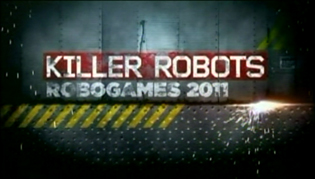
There. I just needed a transition image so I could shift into using the past tense. That was getting really cumbersome. Incidentally, as I go along, I'm going to assume that you've already seen the "Killer Robots" special that aired on Science Channel. If you haven't... well, I hope you weren't planning on watching it afterward and being surprised.
Friday morning rolled around, and it was time for the builders meeting. I had gotten my information on almost all of the 87 robots -- there are always one or two teams that show up and pass safety really early, then don't appear again until right before it's time to compete. Given how many last-minute adjustments you see in the pits, that always baffles me.
It was the traditional builders meeting -- rules were clarified, safety procedures were explained, important arena staff were identified so the builders knew who to listen to. Then the executive producer of the television production was introduced and said a few words.
He let everybody know that the heavyweight robots would be main focus of the program (the cameras did gather some footage of the lighter robots, but as you saw, they didn't have time to acknowledge the featherweight through middleweight classes during the hour). The executive producer also informed the builders that even though the tournament was double elimination, when the program was cut together, it would be presented as a single elimination tournament, to make it easier for the home viewers to understand.
I agree with him on that -- it is hard to wrap your head around double elimination. I'm sure I've confused more than my fair share of audience members when I try to explain it at the beginning of each day. The only reason I'm able to understand it is because I'm following along with a printout of the brackets.
Of course, if you're competing, you favor double elimination -- it would be incredibly disappointing to spend months putting so much effort into a machine, fighting with it exactly once for three minutes (or less!), and then having nothing to do for the rest of the weekend because you lost your first fight. With double elimination, you get at least one more chance to do something.
So to make it more worthwhile for the competitors (and to give the paying audience more fights), the live tournament was double elimination, while on television, we would be pretending it was single elimination. The executive producer notified everybody that as a result, the various people from the TV crew getting sound bites would be asking questions as if this was a single elimination tournament. No references to fighting the same opponent earlier in the weekend or to getting another chance after a loss.
I was interested in how they were going to pull that off -- I wasn't sure you could pick out fights in a double elimination bracket and rearrange them in a working single elimination ladder. The easiest solution would be to only take the winners bracket fights and present that as its own tournament, but then you wouldn't be able to use any of the compelling fights from the losers bracket.
In fact, let's take a look at the completely-filled-in brackets for this heavyweight competition. Click here (you may want to open this in a new window or tab, as I'll be referring back to it throughout this account).
If you remember all of the fights that were presented in the one-hour "Killer Robots" program, the most surprising thing you'll notice is that Breaker Box never made it onto TV, despite earning a third-place finish in the tournament. (We didn't get to see it compete for third place -- after fighting Death and Taxes, and later Sewer Snake, it was too broken to stand a chance against Last Rites, so Jim Smentowski had to forfeit and settle for third.)
In fact, one of the things that surprised me the most about "Killer Robots" was seeing which machines didn't make it onto TV. There was the aforementioned Breaker Box, solidly-built and capable of doing a cool victory dance. It accumulated four wins, but perhaps because all of the wins were judges' decisions, it didn't make for definitive television.
There was Son of Ziggy, the much-anticipated heavyweight version of the dominant super heavyweight Ziggy (90% of Ziggy at 60% the weight, the team said). The pneumatic flipper was high on my list of robots to keep an eye on during the tournament, but even though it fought four times, scoring two wins by knockout, there was no room for it on TV.
But most surprising of all was the exclusion of Vise Crypt, the new robot from famed BattleBots champion Donald Hutson. It had just been built (and presumably the TV production company visited Donald's shop to get some introductory footage), it looked cool, and Donald Hutson knows how to drive a fighting robot. But it too ended up on the cutting room floor.
During the periods when the arena wasn't being used for fights, the TV cameras were getting lots of supplementary footage for the special. One of the things they did was arrange to interview some non-RoboGames people who have made an important impact on the world of combat robotics. These interviews went on for a while (we weren't allowed to linger if we needed to walk from one side of the building to the other, through the background of the shot), though in the final product, we only got to see the smallest snippets of the interview subjects. This was another reason I was bummed that the Science Channel only agreed to a one-hour special -- not only did it mean the exclusion of some entertaining fights, but considering all of the extra footage being gathered, there was a lot that wouldn't make it to air.
Which is a shame, because I was looking forward to seeing what was said during the interview with Marc Thorpe. That's right -- they interviewed Marc Thorpe, the man who created the original Robot Wars event back in 1994. The interview went on for quite a while, too -- given all the history he's experienced, they could have easily devoted an entire segment just to the early history of the sport. But with only an hour to fill, there was no time to really delve into that, so we didn't get to see any of it.
So what did we get to see? Well, we got to see eleven fights in one hour -- considering that they also had to acquaint viewers with how the robots worked and with the builders behind the robots, that's an impressive feat. Comedy Central's "BattleBots" was never able to fit more than four fights into a half-hour, and that was only if one of the fights was an immediate knockout. But just like the interviews, a lot had to be cut to make it all fit.
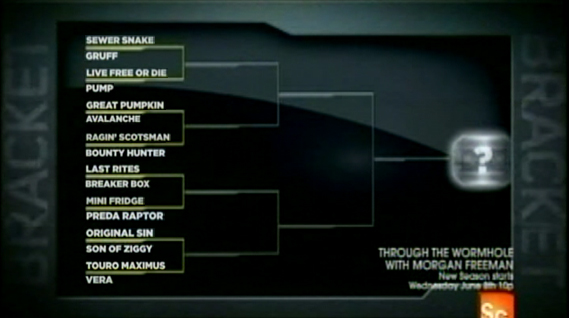
So here are the brackets as imagined by the "Killer Robots" team to create the illusion of a single-elimination event. In the process of taking a finished double-elimination bracket and creating a single-elimination bracket that allowed them to air the fights they wanted to air, I expected that the production company would have to pair up some robots that never actually fought. But to my surprise, all of these match-ups did occur somewhere in the double-elimination tournament. Sure, Original Sin vs. Son of Ziggy happened in the middle of the losers bracket and Last Rites vs. Breaker Box happened after Last Rites faced MiniFridge, but still. As we'll be seeing, the fights presented over the course of the hour weren't in chronological order.
Hey, I just noticed -- for this first round, all of the winning robots are listed on top. In fact, with only one exception, the winning robot is always listed on top in this fictional bracket. It's a good thing it all goes by too fast for anybody to notice.
So let's get started with the first fight.
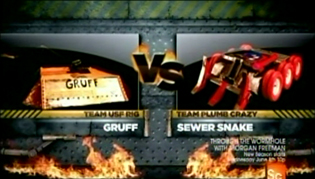
While this was Sewer Snake's first fight of the tournament (thanks to a first-round bye), Gruff had already defeated Vera in a 21-12 judges' decision. As evidenced by the relatively empty bleachers seen while the competitors are loading in their machines, you can tell that this fight took place on Friday, the first day of the tournament (Friday is always the least-attended day of RoboGames, what with the kids in school and parents at work).
The other reason I know this took place on Friday? I'm wearing a black shirt. Nobody on the TV staff had told me how this would all be edited, so I went ahead and brought three changes of clothes for the weekend, just as I always do. A lot of the builders have team shirts that they wear throughout the tournament, but me and my constantly-changing clothing are the giveaway that this special was heavily edited from the source material. In fact, it appears that I change my shirt in the middle of this fight!
Hmm... did I mention that this essay was going to be as much about me as it would be about the robots? You should make your peace with that right now.
Since I was providing a live commentary on all of the fights, the production company mounted a stationary camera to the side of the arena and left it pointed at my face. They also captured all of the audio from my microphone. Unfortunately for them, from my perspective, my microphone was only wired to a couple of big speakers at the corners of the arena. And when fights get exciting, I have a tendency to begin shouting. Even though one of the first rules of microphones is, "If the levels of a microphone have been adjusted to your speaking voice when you're two inches away, then you cannot suddenly shout into the microphone at the same two inches away without severely distorting the sound of your voice." When my voice is being projected over the big speakers in the giant echo-y convention hall, it all sounds the same no matter how loud I'm being. But on tape... well, that's a different story.
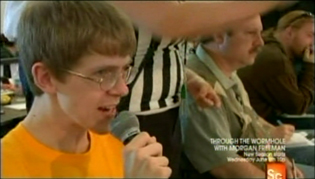
"Three, two, one, fight!"
That's just a clip of me yelling "Fight!" for some other match. Later on, you'll see footage of me from this specific fight.
This fight went pretty much the same way in person as you saw on TV. They edited out a stretch where Sewer Snake dominated Gruff while Gruff's weapon began to fail -- it didn't go immediately from Gruff freeing itself from the arena wall to one last flip from Sewer Snake.

Ah... there I am from this actual fight. I got a haircut the following week. I guess I don't look so bad, but I wish I had at least trimmed my sideburns. It's not like I didn't know I was going to have a camera pointed at me for an entire weekend.
Onward to the next fight!
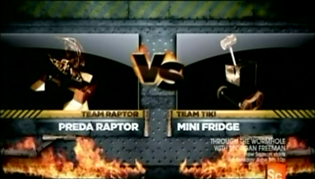
Ah, Preda Raptor versus MiniFridge. As I announced to the live audience, a fight over nine years in the making. It would be unreasonable to expect the "Killer Robots" team to explain exactly why this fight was so important, but that's what I'm here for.
Back in the day (the early 2000s), Team Raptor had built a robot called Tripulta Raptor. They had competed with it at BattleBots but had lost before the robot could reach the televised rounds. During the winter, the builders of Tripulta Raptor were hired to help make a combat robot-themed commercial for Bud Light that would air during the Super Bowl.
In the commercial, a dangerous-looking robot (that looked awfully similar to Tripulta Raptor) was competing against a mini-fridge on wheels. It looked like the toothed robot would destroy the mini-fridge, whose only defense seemed to be to open its door to offer a bottle of Bud Light. When the toothed robot approached the beer, a comically oversized hammer emerged from the mini-fridge and obliterated the frightening competitor in one blow.
BattleBots responded to the ad by suing Anheuser-Busch for infringing on its trademarks, including its rights to use the images of its competitors for a set period of time. I wasn't there, but I'd infer that the whole ordeal did not result in a lot of happy smiling people.
But now it's 2011 -- BattleBots's image rights to the competitors in its Comedy Central series have expired. Tripulta Raptor was renamed Preda Raptor and continued to fight, off and on, at various other events. And when Team Tiki learned that Preda Raptor would be at this year's RoboGames, they knew what they had to do.
They had to build a mini-fridge robot.
You're not allowed to build a robot that releases liquid, or else I'm sure they would have stuck a bottle of beer right in the fridge. But everything else -- a combat robot shaped like a mini-fridge that uses an overhead hammer as a weapon -- came to life in the appropriately-named MiniFridge (in fact, Team Tiki had prepared to build this robot for the previous ComBots Cup event, but when they learned that Preda Raptor had to pull out, they waited for the next opportunity).
All of the long-time builders were anxious to see this fight. The sport's contentious legal history is a topic that just isn't discussed publicly (I recommend "Gearheads" -- an excellent book all about the legal battles fought over robotic combat). This fight was an opportunity for everyone to share a wink and a nod over the sport's turbulent past.
As I introduced the robots, I told the live audience that MiniFridge's strategy would be to tempt Preda Raptor with something to drink, then hit Preda Raptor with the hammer while it was distracted. I never referenced the Super Bowl ad or the lawsuit, but hopefully there were a couple of audience members in the know who got the joke. Since I wasn't sure what the Science Channel's policy was on alcohol references, I stuck with the phrase "cool, frosty beverage" (which you can hear me say during the fight).
This was another Friday fight -- one of the first fights of the heavyweight tournament, if I remember correctly. The clip of me counting down is taken from another day. I would also like to state that at no point did I ever add a big dramatic pause between "one" and "fight."
Incidentally, while Preda Raptor is introduced in this special as having crushing jaws as its weapon, and while at one point in time, the robot did use its jaws as a crushing weapon, for this tournament, the hydraulics were disabled and the jaws were being used simply to manipulate and lift opponents. But that doesn't sound as cool when you're staring at a robot with giant teeth, and besides, we're not going to be seeing Preda Raptor for long, anyway. Might as well hype up the cool-sounding stuff it used to do.
Like all of the fights in this special, this one went on longer than the edited footage would have you believe. And the crowd chanting "MiniFridge! MiniFridge!" -- the TV team shot that during one of the breaks in the action. The audience never starts spontaneously chanting in the middle of a fight. Or at the end, for that matter.
And it turns out that the commercial was right -- a mini-fridge can defeat a combat robot. Who knew.
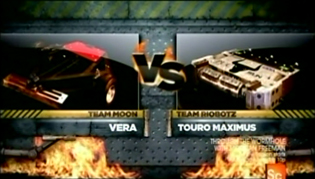
This was a fight from early in the losers bracket. This is Vera's second fight, having lost to Gruff in its first round. Touro Maximus has already fought twice in this tournament, defeating Double Rainbow Party in a split decision and losing to Original Sin... in a fight that we'll be seeing later on in this special. Like I said, the production team had to air fights out of order to make their bracket work.
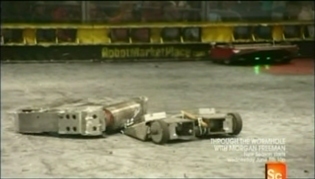
As we're introduced to Touro Maximus, Grant tells us that they took second place at RoboGames 2010. Of course, there were no television crews covering RoboGames 2010, so the footage you see is from the 2011 tournament -- mostly its fight against multibot Death and Taxes, which took place later in the bracket.
Death and Taxes, incidentally, is another heavyweight entry from Team Moon, the team behind Vera.
I kind of wish the show had introduced Vera after introducing Last Rites. I'm not sure how casual viewers interpreted seeing two similar-looking bar spinners. While Team Moon has fought for years and years with many robots, this was the first tournament for Vera.
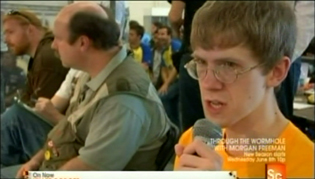
To mix up the many shots of me, during my warning to the audience to not press their faces directly against the Lexan, the TV team has flipped the camera image horizontally. Those are the judges next to me -- you'll see them on the correct side less than ten seconds later. Darned if I can remember whether this was the specific warning I gave for this specific fight -- it seems like every two fights, the kids in the audience all start to creep across the caution tape.
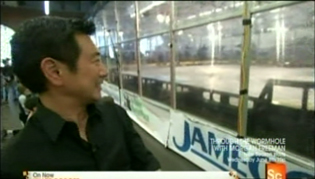
Even Grant had to be careful not to stand too close to the arena for this fight.
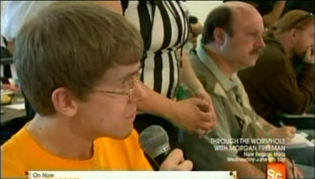
This shot always amuses me. I count down from three (technically, five, but that was edited for time) and half a beat after I say "Fight!", I abruptly shift my head to full profile to watch the fight. You see, with a camera mounted to the arena wall, my seat perpendicular to the arena wall meant that the standard shot of me had me looking too far to the side to make for good television. So for the entire weekend, my chair was angled so that I would face the camera at a better-looking angle (they even marked the floor so I'd know where to put the chair if it got moved). Of course, once the fight began, I wanted to focus my attention on what was going on, so once the robots started moving, I quit worrying about looking good for the camera and just turned my head toward the center of the arena. I love that out of context, I resemble a dog that has just seen a squirrel in its backyard.
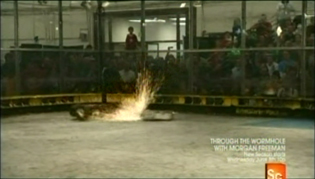
This was a controversial fight. And given how your typical reality show loves to take any small bit of drama and blow it way out of proportion, I have to give major props to this production company for actually completely ignoring the controversy, which didn't reflect that well on the sport.
Suffice it to say: The hit you see above was the last big hit of the fight. With only one side of its drive working and its bar now broken in half, there was no way Vera was going to win this fight. At this point, Team Moon tapped out.
But the members of Team RioBotz, as they always do, were going absolutely ape-poopie on their driving platform. So much so that they didn't hear Team Moon tap out, nor did they hear the referee yelling that it was a tap-out, nor did they hear me repeatedly saying over the microphone while waving at them that it was a tap-out. They were too caught up in their celebration.
The hit that flipped Vera over the wall happened after the tap-out. The audio of me announcing the hit is pretty clearly pieced together from narration earlier in the fight -- in fact, the phrase "flipping Vera [...] over" is the same bit of audio you already heard a few seconds ago. At this point, everybody was trying to get RioBotz to quit fighting already.
And that was just the in-fight controversy. RioBotz celebrated their win, as they always do, by pounding against the arena wall as hard as they possibly could. But this time, they were three feet away from a camera attached to the arena wall. They shook the wall so much, my stationary camera dislodged from its clamp and fell to the floor.

This shot is actually from the next day -- I think it's from the conclusion of the Death and Taxes match. I'm in the orange in the lower left-hand corner. While it looks like I'm pointing to Team RioBotz as the winners, in reality, I'm holding out my hand in preparation to catch the camera, in case they knock it loose again. The camera stayed put for the remainder of the weekend, but Team RioBotz was given a warning to tamp their victory celebrations.
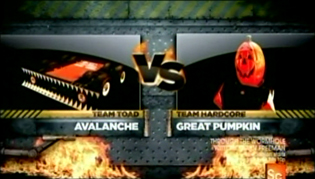
I'm surprised this one made it to air -- I wouldn't have expected a pusher-on-pusher fight to be one of the ones selected for TV. I think it's an important lesson to builders that if your robot is visually interesting (say, if you put a big plastic Halloween decoration on it), you're more likely to get on TV. Also, this gave the production team a reason to justify the expense they incurred to fly out to Texas to interview Team Toad.
Not much to say about this fight. As you saw, it went the full three minutes, though most of that time was spent in driving and pushing stalemates. Everybody knew that The Great Pumpkin was going to get the judges' decision -- Avalanche had lost part of its drive, allowing The Great Pumpkin to be more aggressive. In fact, the final score was a lopsided 24 to 9.
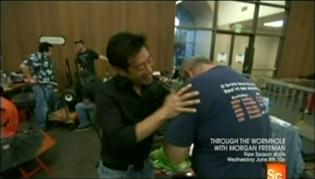
I love this little moment -- you can tell Grant and Fuzzy know each other back from when they both competed at BattleBots. I like that this special made sure not to ignore the humans behind the machines... I just wish there had been more than an hour to fit everything in.
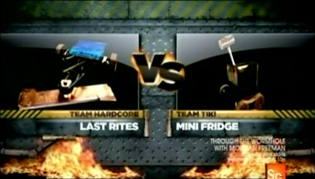
After MiniFridge defeated Preda Raptor, it moved on to face Last Rites (Preda Raptor should thank its lucky stars that it lost that fight).
In watching this back, I was surprised that the fight went all the way. But MiniFridge was able to hang in there for the full time, not that it had much to offer against Last Rites besides resiliency. The score was indeed 23-10, though given my casual announcement of the score, we all knew that the winner would be Last Rites -- the pause was added in post-production to try to create some sense of drama (since at home, you didn't get to see Last Rites dominate for the full three minutes).
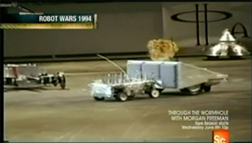
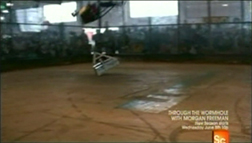
And here's all the time we had to talk about the early history of the sport. That image on the right is from one of my favorite fights of all time -- SubZero versus The Mortician from RoboGames 2007. The Mortician, as all you fans of robot combat know, is the middleweight version of Last Rites. SubZero was a powerful pneumatic flipper. Early in the fight, The Mortician had delivered a blow to SubZero, causing SubZero to begin leaking its pneumatic gas. With limited time left before its weapon became useless, SubZero got underneath The Mortician, activated the flipping arm, and sent The Mortician into the trusses at the top of the arena. The Mortician actually grazed the top of the arena! When it landed, The Mortician's batteries popped out, and SubZero won the fight.
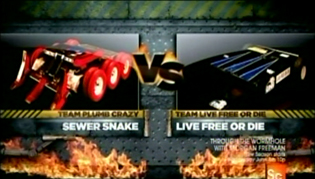
Here we are in the winners bracket. This is Sewer Snake's second fight. Live Free or Die has defeated two other heavyweights to reach this point.
At the end of this battle, the reason you don't immediately hear me call the fight a knockout is because, as Matt explained in his exit interview, Live Free or Die never touched the floor behind the rails (it's not an instant knockout unless the robot touches the floor). Live Free or Die had the opportunity to try to free itself back onto the fighting surface, but it couldn't do so, giving Sewer Snake the win. The audience always loves it when a robot is defeated by being tossed over the rails. That, plus its sweet breakdancing moves, is why Sewer Snake is one of the crowd favorites.
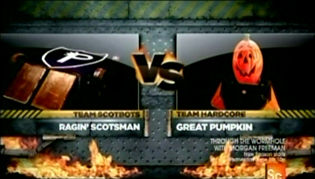
And here's our introduction to Ragin' Scotsman. To get to this point in the winners bracket, it defeated Bounty Hunter and KJO, both of which we see during the introductory clips.
Since it's one of the questions I hear most often about this robot, the purple and the kilts aren't there frivolously -- the team is showing their school pride by wearing the colors of their high school, the mascot of which is the Highlander. It's a team of high school students who have built a successful flamethrowing heavyweight robot. They were naturals to be profiled in this special.
They awkwardly edited out the part where I announced the actual judges' scores, but this fight ended 23-10 -- Ragin' Scotsman was the clear winner.
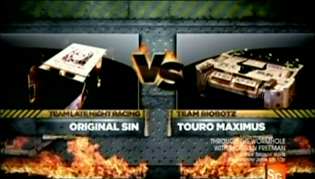
After a brief segment on the dozens of other competitive events that take place at every RoboGames, we return to the primary draw -- robotic combat.
So as I said, this fight actually took place on Friday. I don't doubt that the interview with Team RioBotz about all the repairs they've had to do to their robot took place after its fight with Vera, but none of that matters here, because this fight took place 24 hours earlier.
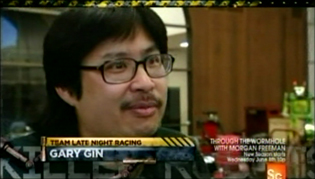
It's late Friday night -- through the windows (in the upper left of this screen grab), you can see the sun is going down. Also, most of the spectators have gone home for the evening. Thanks to a bye, this was Original Sin's first fight of the weekend, with Touro Maximus having to defeat only one opponent to get here.
I don't have much to say about this fight, other than I have no idea why there's a shot of a functional Touro Maximus mixed in with the other shots while I'm counting it down to a knockout. I guess that a robot sitting in the corner isn't very visually interesting.
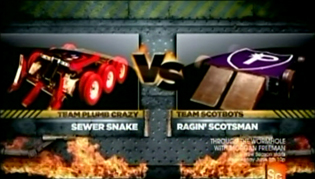
Two good drivers here, but I think that when Ragin' Scotsman lost a tire, that may have cost it the match. If there had been no damage, I wouldn't have been surprised to see this one end on a 17-16 split decision, and who knows which way that would have gone.
Ragin' Scotsman went on to face Original Sin, but when it comes to wedge-on-wedge fights, it's incredibly difficult to outdrive Gary Gin. Which brings us to our next fight in this special.
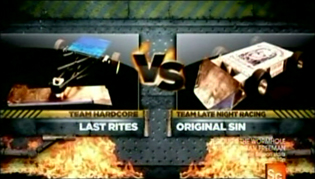
Up to this point, I opined that it was too bad that the heavyweights would be the focus of this special, as the middleweights were putting on a more interesting show in the tournament. Including a fight between Brazilian robots Besta and Maloney in which Besta ripped off and flung Maloney's wedge so violently that it cracked the Lexan in the arena door, necessitating a lengthy stop while the door was repaired. The TV crew got lots of footage of the repairs (though in general, they hadn't been recording the fights in the lighter weight classes), but there was no place to air it.
It was this fight, between Last Rites and Original Sin, that was easily the best fight of the heavyweight tournament. Each robot had already lost once (Last Rites to Breaker Box, and Original Sin to Last Rites in a fight that surprisingly ended with a fizzle when Original Sin just abruptly stopped working because its crystal broke). As it would turn out, due to a forfeit in the final losers bracket fight, the winner of this fight really would be advancing to the finals to fight Sewer Snake.
Oh, how I wish the TV production team had let this one play out in real time. Watch this video on YouTube -- it's just as exciting and doesn't feel as disjointed. It's the overarching theme of my account of this special -- they needed more than one hour to fit all of the good stuff in.
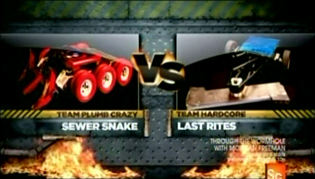
Theoretically, I guess they didn't have to show the final fight as the final fight of the episode. But I'm glad they did. Sewer Snake came into this fight from the winners side of the double elimination bracket, so a loss for Sewer Snake would mean that the two robots would have to fight again to truly determine the champion. And would probably mean a weird continuity problem with a busted-up Sewer Snake if that was the fight that aired.
I was too busy announcing other fights to notice, but as you saw, there was a scramble in the pits to try to get a functioning weapon motor on Last Rites. I don't know what made it suddenly start working shortly after the fight began, but thank goodness it did, or this special would have ended with a thud.
But here's the thing -- this fight wasn't as close as the TV show would have you believe. In reality, a little over a minute into the fight, Last Rites lost the drive to one side of its body and Sewer Snake pushed it into a corner, where it had trouble moving anywhere. The weapon motor gave up shortly thereafter. Barring some unexpected malfunction, it was evident that Sewer Snake was going to win the fight, although it was nice of Sewer Snake to deliver a knockout blow (which happened with more than 30 seconds left on the clock, regardless of what the editing portrayed).
So yeah, Sewer Snake defeated Last Rites by knockout, but the way it was presented on TV wasn't all that close to what happened in real life. I don't see why they felt the need to add so much fictional drama to the fight. Let Sewer Snake have its well-earned victory on its own merits.
Still, it was an exciting end to the heavyweight tournament. I was absolutely screaming into my microphone, so it's a credit to the post-production team that they were able to adjust the levels to anything approaching intelligibility for television.
The interview with Team PlumbCrazy inside the arena didn't happen quite as immediately as you might think, since the two teams first had to go in and turn off their robots, followed by moving Sewer Snake toward the middle and setting up the shot. We politely asked the crowd to stick around so there wouldn't be empty bleachers in the background. Most of them did, though you can see things thinning out a little bit. It goes without saying that the close-up shots of cheering audience members were taped earlier in the day.
With that, Grant closed out the program, saying "See you next year!". We were all optimistic that this would become a yearly special. After all, robotic combat is exciting, and 2011's heavyweight tournament, though it did have its highs and lows, produced enough compelling fights that we figured viewers would turn out in high enough numbers to warrant a sequel. I wish I knew why they didn't come back for 2012.
As I've already said approximately 75 times in this recap, I attribute it to trying to fit too much content into too little time. Covering eleven fights in an hour was admirable, but instead of broadcasting the natural ebbs and flows of a fight, battles were reduced to a collection of highlight clips. Perhaps viewers couldn't get invested because everything went by so fast. There was plenty to take in, and a one-hour time slot didn't do the content justice.
C'est la vie. This special didn't wind up making much of an impact on the sport as a whole, but at least it didn't hurt, either. It was nice to see robotic combat return to TV after so many years of nothing, and it's always fun getting to be on TV. I want to write some grand conclusion pinpointing this special's place in history, but the truth is, it was an hour of television that will ultimately be forgotten. Still, it was better than anything that aired on, say, TLC during the year. And maybe, just maybe, that's good enough.